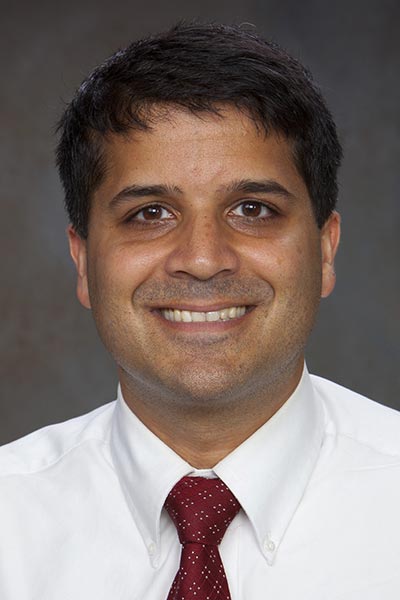Researchers working on novel strategies to improve radiation therapy
Radiation therapy is used in about 60 percent of cancers for either curative or palliative purposes, and the response to radiation by individual patients is influenced by both tumor-intrinsic and tumor-extrinsic factors. Specific features of the tumor microenvironment can affect tumor oxygenation and certain metabolic pathways, leading to radiation resistance.
Other pathways can modulate both the tumor microenvironment and distant microenvironments, leading to therapeutic resistance and distant metastases. Understanding and targeting these pathways may lead to novel strategies to enhance the efficacy of radiation therapy in solid tumors at the individual level, and possibly open the way to novel radiotherapy-drug combinations.
Three researchers explored the potential of these novel strategies during an Annual Meeting symposium on Monday, April 17. The session, Radiation Therapy, DNA Damage, and Immune Response, can be viewed on the virtual meeting platform by registered Annual Meeting participants through July 19, 2023.

Hypoxia is one of the familiar variables in radiation and other cancer therapies. Hypoxia has been associated with radiation resistance and poor radiation outcomes for at least 50 years, noted Bradly G. Wouters, MSc, PhD, Senior Scientist at Princess Margaret Cancer Center, Toronto, Canada.
“Radiation, chemotherapy, and other stressors can elicit a range of hypoxic responses and biological responses that change tumor phenotypes in response to stress,” he said.
ULK1, a kinase that plays a role in the initiation of autophagy as well as the turnover of both mitochondria and endoplasmic reticulum (ER), is essential for the survival of cells under hypoxia. Loss or inhibition of ULK1 results in defects in mitochondrial and ER turnover, leading to increases in oxygen consumption within the tumor and development of more hypoxia, and promoting the death of cells that become hypoxic. Wouters showed that ULK1 loss had a therapeutic effect in a mouse model of pancreatic ductal adenocarcinoma (PDAC).
Transcriptional analysis of PDAC patient-derived organoids identified five transcriptional subtypes. During hypoxia, some organoids shift to more aggressive subtypes, and some go into remission.
“Understanding what drives hypoxia is going to be essential in designing clinical approaches,” Wouters said.
Tumor hypoxia is linked to worse survival in head and neck cancers and decreased effectiveness of immune therapy. Hypoxia also modulates secretion of galectin-1 (Gal-1), a galactoside binding protein that interacts with proteins on the cell surface and in the extracellular matrix.

“Gal-1 expression is up-regulated during embryonic and tumor development,” said Quynh-Thu Le, MD, the Katharine Dexter McCormick and Stanley McCormick Memorial Professor at Stanford University and Co-Director of the Radiation Biology Program at the Stanford Cancer Institute. “High Gal-1 levels also correlate with tumor growth and progression. It shapes the immune landscape, angiogenesis, and glycosylation.”
Multiple mouse models have shown that Gal-1 blocks T-cell infiltration into tumors. The absence of Gal-1 enhances T-cell infiltration. Anti-Gal-1 treatment can enhance T-cell infiltration and improve response to anti-PD-1 therapy, Le said.
Radiation increases circulating Gal-1 levels, leading to T-cell death and lymphopenia. Inhibiting Gal-1 enhanced the combined effect of radiation and anti-PD-1 therapy in a mouse model.
“We are developing new ways to target Gal-1 in combination with radiation therapy, chemotherapy, and immunotherapy, and learning more about Gal-1 intracellular functions to optimize targeting,” Le said. “We are trying to determine how best to move this approach into the clinic.
Targeted DNA damage is a strategy to stimulate response to immunotherapy. And while damaging DNA using radiation, chemotherapy, and other approaches has therapeutic promise, it can also give rise to immunosuppression.

“There is a complex balance between immunogenic cell death, immunosuppression, and toxicity,” said Ranjit S. Bindra, MD, PhD, the Harvey and Kate Cushing Professor of Therapeutic Radiology, Pathology, and Neurosurgery at Yale School of Medicine. “There are class-specific and drug-specific considerations for DNA-damaging agents.”
Combining radiation or other DNA-damaging agents with DNA damage repair (DDR) inhibitors is one possible approach, Bindra said.
To maximize tumor cell killing while minimizing normal immune cell death from radiation, one option could be to use protons. The proton approach may allow for better tumor tissue coverage while sparing more uninvolved structures.
It may also be possible to combine targeted DNA damage with immunotherapy, Bindra said.
More from the AACR Annual Meeting 2025
View a photo gallery of scenes from Chicago, continue the conversation on social media using the hashtag #AACR25, and read more coverage in AACR Annual Meeting News.

